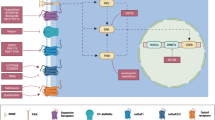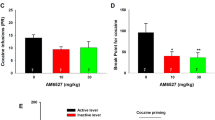Abstract
Environmental stimuli that are reliably associated with the effects of many abused drugs, especially stimulants such as cocaine, can produce craving and relapse in abstinent human substance abusers1,2,3,4. In animals, such cues can induce and maintain drug-seeking behaviour and also reinstate drug-seeking after extinction5,6,7. Reducing the motivational effects of drug-related cues might therefore be useful in the treatment of addiction3. Converging pharmacological8,9, human post-mortem10 and genetic11 studies implicate the dopamine D3 receptor12 in drug addiction. Here we have designed BP 897, the first D3-receptor-selective agonist, as assessed in vitro with recombinant receptors and in vivo with mice bearing disrupted D3-receptor genes. BP 897 is a partial agonist in vitro and acts in vivo as either an agonist or an antagonist. We show that BP 897 inhibits cocaine-seeking behaviour that depends upon the presentation of drug-associated cues, without having any intrinsic, primary rewarding effects. Our data indicate that compounds like BP 897 could be used for reducing the drug craving and vulnerability to relapse that are elicited by drug-associated environmental stimuli.
This is a preview of subscription content, access via your institution
Access options
Subscribe to this journal
Receive 51 print issues and online access
$199.00 per year
only $3.90 per issue
Buy this article
- Purchase on Springer Link
- Instant access to full article PDF
Prices may be subject to local taxes which are calculated during checkout




Similar content being viewed by others
References
Wikler, A. Dynamics of drug dependence. Arch. Gen. Psychiatry 28, 611–6161 (1973).
O'Brien, C. P., Childress, A. R., McMellan, A. T. & Ehrman, R. A. Alearning model of addiction. Res. Publ. Assoc. Res. Nerv. Ment. Dis. 70, 157–177 (1992).
O'Brien, C. P. & McMellan, A. T. Myths about the treatment of addiction. Lancet 347, 237–240 (1996).
Grech, D. M., Spealman, R. D. & Bergman, J. Self-administration of D1receptor agonists by squirrel monkeys. Psychopharmacology 125, 97–104 (1996).
de Wit, H. & Stewart, J. Reinstatement of cocaine-reinforced responding in the rat. Psychopharmacology 75, 134–143 (1981).
Meil, W. M. & See, R. E. Lesions of the basolateral amygdala abolish the ability of drug associated cues to reinstate responding during withdrawal from self-administered cocaine. Behav. Brain Res. 87, 139–148 (1997).
Arroyo, M., Markou, A., Robbins, T. W. & Everitt, B. J. Acquisition, maintenance and reinstatement of intravenous cocaine self-administration under a second-order schedule of reinforcement in rats: effects of conditioned cues and continuous access to cocaine. Psychopharmacology 140, 331–344 (1999).
Caine, S. B. & Koob, G. F. Modulation of cocaine self-administration in the rat through D3dopamine receptors. Science 260, 1814–1816 (1993).
Caine, S. B.et al. D3receptor test in vitro predicts decreased cocaine self-administration in rats. Neuroreport 8, 2373–2377 (1997).
Staley, J. K. & Mash, D. C. Adaptive increase in D3 dopamine receptors in the brain reward circuits of human cocaine fatalities. J. Neurosci. 16, 6100–6106 (1996).
Duaux, E.et al. Homozygosity at the dopamine D3receptor gene is associated with opioid dependence. Mol. Psychiatry 3, 333–336 (1998).
Sokoloff, P., Giros, B., Martres, M.-P., Bouthenet, M.-L. & Schwartz, J.-C. Molecular cloning and characterization of a novel dopamine receptor (D3) as a target for neuroleptics. Nature 347, 146–151 (1990).
Xu, M., Koeltzow, T. E., Cooper, D. C., Tonegawa, S. & White, F. J. Dopamine D3receptor mutant and wild-type mice exhibit identical responses to putative D3receptor-selective agonists and antagonists. Synapse 31, 210–215 (1999).
Pilon, C.et al. Functional coupling of the human dopamine D3receptor in a transfected NG 108-15 neuroblastoma-glioma hybrid cell line. Eur. J. Pharmacol. 268, 129–139 (1994).
Sautel, F.et al. Nafadotride, a potent preferential dopamine D3receptor antagonist, activates locomotion in rodents. J. Pharmacol. Exp. Ther. 275, 1239–1246 (1995).
Bordet, R.et al. Induction of dopamine D3receptor expression as a mechanism of behavioral sensitization to levodopa. Proc. Natl Acad. Sci. USA 94, 3363–3367 (1997).
Ridray, S.et al. Coexpression of dopamine D1and D3receptors in rat ventral striatum: opposite and synergistic functional interactions. Eur. J. Neurosci. 10, 1676–1686 (1998).
Accili, D.et al. Atargeted mutation of the D3receptor gene is associated with hyperactivity in mice. Proc. Natl Acad. Sci. USA 93, 1945–1949 (1996).
Costa, T., Ogino, Y., Munson, P. J., Oraran, H. O. & Rodbard, D. Drug efficacy at guanine nucleotide-binding regulatory protein linked receptors: thermodynamic interpretation of negative antagonism and of receptor activity in the absence of ligand. Mol. Pharmacol. 41, 549–560 (1992).
Leff, P. The two-state model of receptor activation. Trends Pharmacol. Sci. 16, 89–97 (1995).
Caine, S. B. & Koob, G. F. Pretreatment with the dopamine agonist 7-OH-DPAT shifts the cocaine self-administration dose-effect function to the left under different schedules in the rat. Behav. Pharmacol. 6, 333–347 (1995).
Pulvirenti, L. & Koob, G. F. Dopamine agonists, partial agonists and psychostimulant addiction. Trends Pharmacol. Sci. 15, 374–379 (1994).
Grant, S.et al. Activation of memory circuits during cue-elicited cocaine craving. Proc. Natl Acad. Sci. USA 93, 12040–12045 (1996).
Weissenborn, R., Robbins, T. W. & Everitt, B. J. Effects of medial prefrontal or anterior cingulate cortex lesions on responding for cocaine under fixed-ratio and second-order schedules of reinforcement in rats. Psychopharmacology 134, 242–257 (1997).
Whitelaw, R. B., Markou, A., Robbins, T. W. & Everitt, B. J. Excitotoxic lesions of the basolateral amygdala impair the acquisition of cocaine-seeking behaviour under a second-order schedule of reinforcement. Psychopharmacology 127, 213–224 (1996).
Everitt, B. J. & Robbins, T. W. in The Amygdala: Neurological Aspects of Emotion, Memory and Mental Dysfunction (ed. Aggleton, J.) 401–429 (Wiley, New York, 1992).
Lévesque, D.et al. Identification, characterization and localization of the dopamine D3receptor in rat brain using 7-[3H]-hydroxy-N,N di-n-propyl-2-aminotetralin. Proc. Natl Acad. Sci. USA 89, 8155–8159 (1992).
Fontana, D. J., Post, R. M. & Pert, A. Conditioned increases in mesolimbic dopamine overflow by stimuli associated with cocaine. Brain Res. 629, 31–39 (1993).
Di Ciano, P., Blaha, CD. & Phillips, A. G. Conditioned changes in dopamine oxidation currents in the nucleus accumbens of rats by stimuli paired with self-administration or yoked-administration of d-amphetamine. Eur. J. Neurosci. 10, 1121–1127 (1998).
Self, D. W., Barnhart, W. J., Lehman, D. A. & Nestler, E. J. Opposite modulation of cocaine-seeking behavior by D1-like and D2-like dopamine-receptor agonists. Science 271, 1586–1589 (1996).
Acknowledgements
We thank C. Pilon for technical assistance and S. Fuchs, W. Rostene and C. Betancur for providing the D3-receptor-deficient mice. The work was supported by a Biomed II Programme grant to P.S., C.G.W. and B.J.E., a National Institute on Drug Abuse grant to P.S. and C.G.W. and an MRC Programme grant to B.J.E.
Author information
Authors and Affiliations
Corresponding authors
Rights and permissions
About this article
Cite this article
Pilla, M., Perachon, S., Sautel, F. et al. Selective inhibition of cocaine-seeking behaviour by a partial dopamine D3 receptor agonist. Nature 400, 371–375 (1999). https://doi.org/10.1038/22560
Received:
Accepted:
Issue Date:
DOI: https://doi.org/10.1038/22560
This article is cited by
-
Exploring the role of the Ser9Gly (rs6280) Dopamine D3 receptor polymorphism in nicotine reinforcement and cue-elicited craving
Scientific Reports (2020)
-
Improving translation of animal models of addiction and relapse by reverse translation
Nature Reviews Neuroscience (2020)
-
Brexpiprazole reduces hyperactivity, impulsivity, and risk-preference behavior in mice with dopamine transporter knockdown—a model of mania
Psychopharmacology (2017)
-
The Addiction-Related Gene Ankk1 is Oppositely Regulated by D1R- and D2R-Like Dopamine Receptors
Neurotoxicity Research (2016)
-
Effects of buspirone and the dopamine D3 receptor compound PG619 on cocaine and methamphetamine self-administration in rhesus monkeys using a food-drug choice paradigm
Psychopharmacology (2015)
Comments
By submitting a comment you agree to abide by our Terms and Community Guidelines. If you find something abusive or that does not comply with our terms or guidelines please flag it as inappropriate.



